The Book Whisperer (24 page)
Read The Book Whisperer Online
Authors: Donalyn Miller,Jeff Anderson

Appendix C: Student Forms
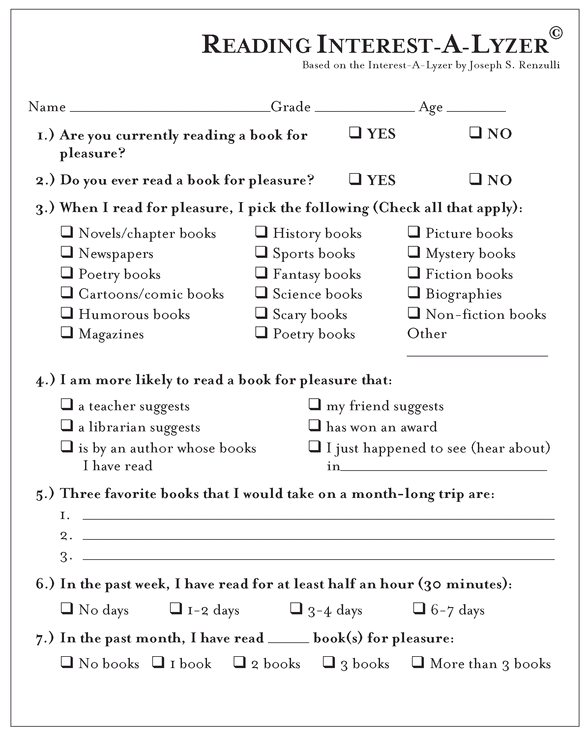
Source
: Reis et al., 2005. “Reading Interest-A-Lyzer.” Copyright © 2005 by Sally M. Reis. Based on the
Interest-A-Lyzer
by Joseph S. Renzulli.
: Reis et al., 2005. “Reading Interest-A-Lyzer.” Copyright © 2005 by Sally M. Reis. Based on the
Interest-A-Lyzer
by Joseph S. Renzulli.
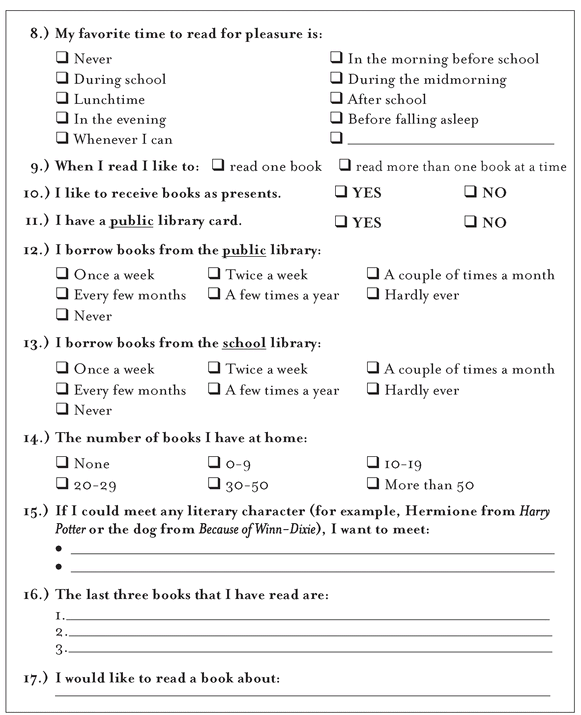
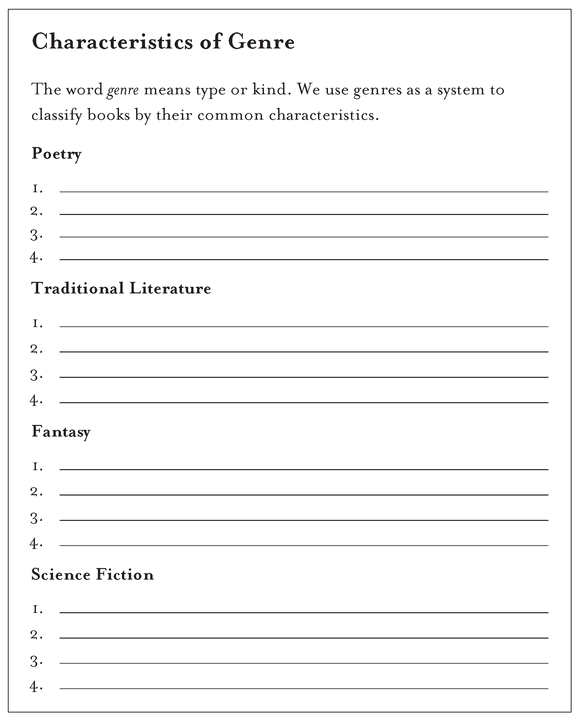
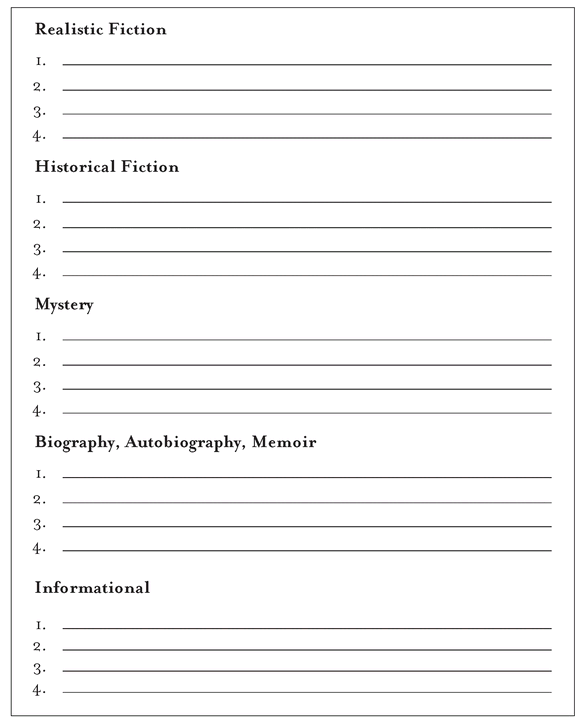
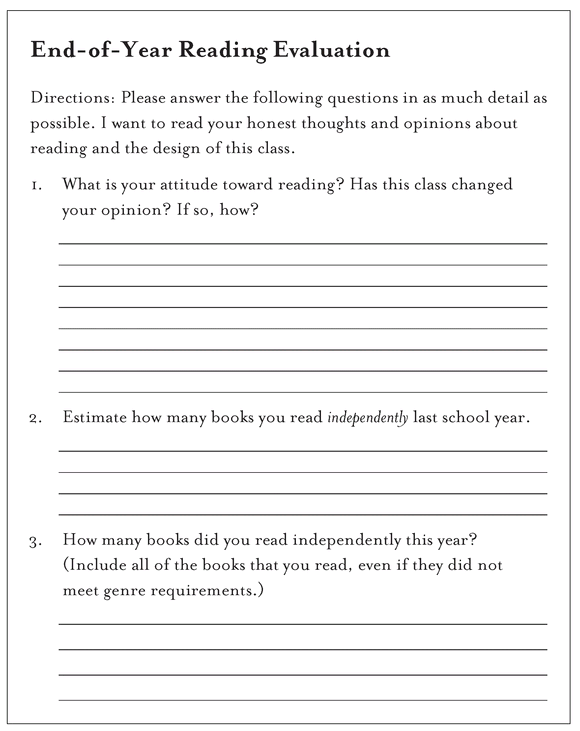
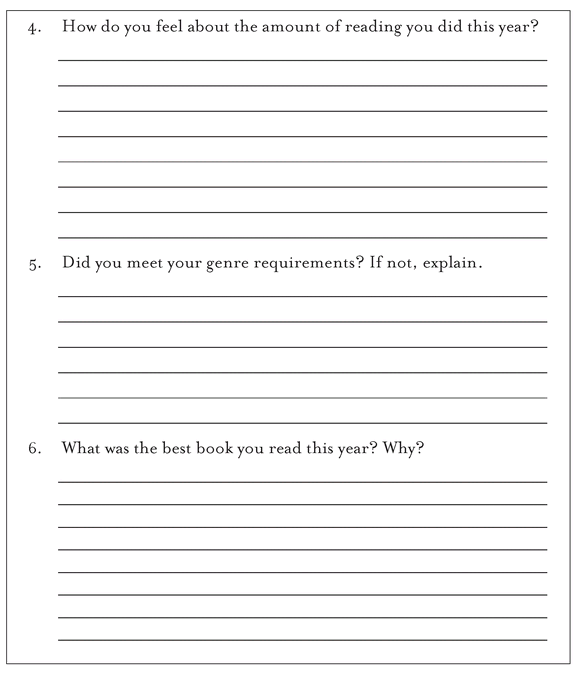
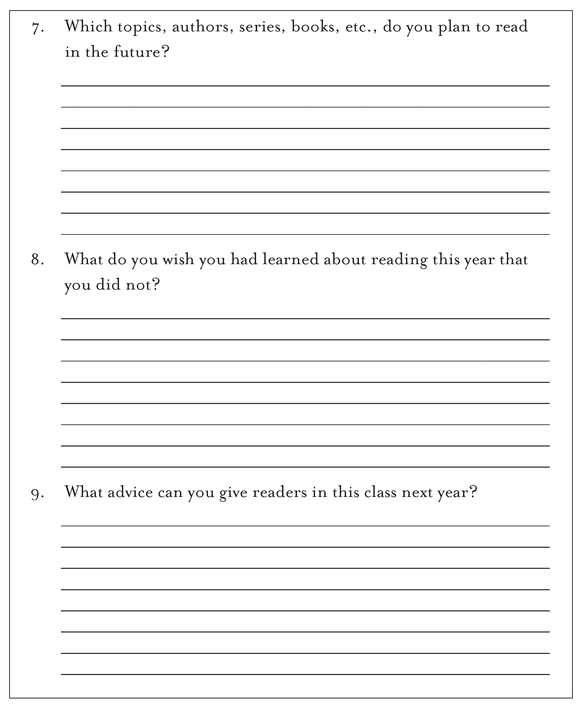
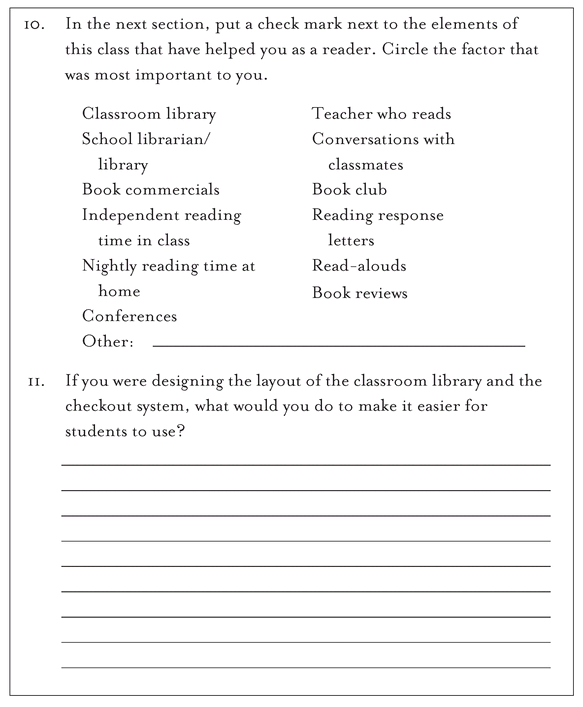
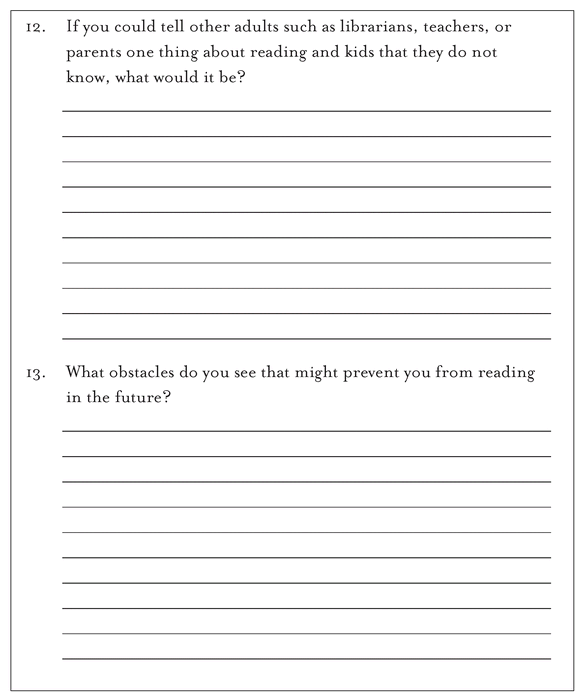
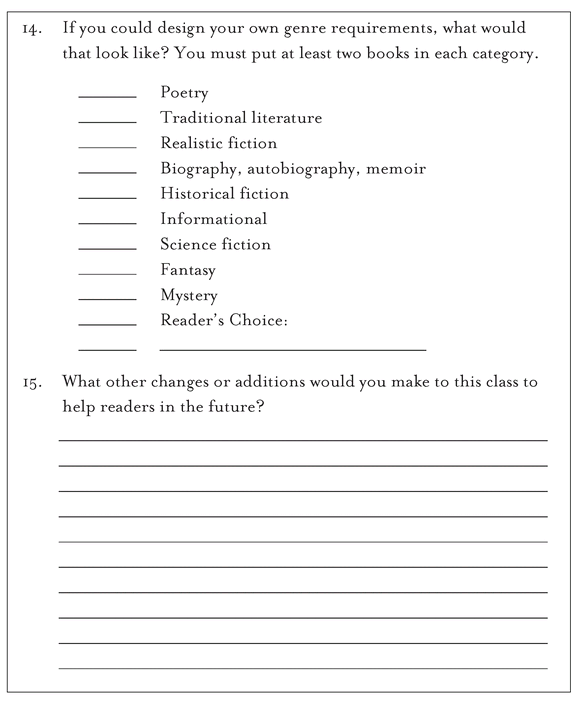
References
Allen, J. (2000).
Yellow brick roads: Shared and guided paths to independent reading 4-12
. Portland, ME: Stenhouse.
Yellow brick roads: Shared and guided paths to independent reading 4-12
. Portland, ME: Stenhouse.
Allington, R. L. (1977). If they don't read much, how they ever gonna get good ?
Journal of Reading
(later renamed
Journal of Adolescent and Adult Literacy)
,
21
, 57-61.
Journal of Reading
(later renamed
Journal of Adolescent and Adult Literacy)
,
21
, 57-61.
Allington, R. L. (2006).
What really matters for struggling readers: Designing research-based programs
. Boston: Pearson.
What really matters for struggling readers: Designing research-based programs
. Boston: Pearson.
Alsup, J., & Bush, J. (2003).
But will it work with real students? Scenarios for teaching secondary English language arts
. Urbana, IL: National Council of Teachers of Language Arts.
But will it work with real students? Scenarios for teaching secondary English language arts
. Urbana, IL: National Council of Teachers of Language Arts.
Anderson, R. C., Hiebert, C. H., Scott, J. A., & Wilkinson, I.A.G. (1985).
Becoming a nation of readers: The report of the Commission on Reading
. Washington, DC: National Institute of Education.
Becoming a nation of readers: The report of the Commission on Reading
. Washington, DC: National Institute of Education.
Applegate, A. J., & Applegate, M. D. (2004). The Peter effect: Reading habits and attitudes of preservice teachers.
Reading Teacher
,
57
(6), 554-563.
Reading Teacher
,
57
(6), 554-563.
Atwell, N. (1998).
In the middle: New understandings about writing, reading, and learning
. Portsmouth, NH: Heinemann.
In the middle: New understandings about writing, reading, and learning
. Portsmouth, NH: Heinemann.
Blasingame, J. (2007).
Books that don't bore 'em: Young adult books that speak to this generation
. New York: Scholastic.
Books that don't bore 'em: Young adult books that speak to this generation
. New York: Scholastic.
Calkins, L. (1994).
The art of teaching writing
. Portsmouth, NH: Heinemann.
The art of teaching writing
. Portsmouth, NH: Heinemann.
Cambourne, B. (1995). Toward an educationally relevant theory of literacy learning: Twenty years of inquiry.
Reading Teacher
,
49
(3), 182-190.
Reading Teacher
,
49
(3), 182-190.
Crowe, C. (1999, September). Young adult literature.
English Journal
,
89
(1), 139.
English Journal
,
89
(1), 139.
Elmore, R. F. (2002, May). Hard questions about practice.
Educational Leadership
,
59
(8), 22-25.
Educational Leadership
,
59
(8), 22-25.
Fisher, D., & Ivey, G. (2007, March). Farewell to
A Farewell to Arms:
Deemphasizing the whole-class novel.
Phi Delta Kappan
, pp. 494-497.
A Farewell to Arms:
Deemphasizing the whole-class novel.
Phi Delta Kappan
, pp. 494-497.
Fountas, I., & Pinnell, G. (2001).
Guiding readers and writers (Grades 3-6): Teaching comprehension, genre, and content literacy
. Portsmouth, NH: Heinemann.
Guiding readers and writers (Grades 3-6): Teaching comprehension, genre, and content literacy
. Portsmouth, NH: Heinemann.
Fram, A. (2007, August 21). One in four read no books last year. Retrieved August 22, 2007, from
The Washington Post
at
http://www.washingtonpost.com/wp-dyn/content/article/2007/08/21/AR2007082101045.html
The Washington Post
at
http://www.washingtonpost.com/wp-dyn/content/article/2007/08/21/AR2007082101045.html
Gambrell, L. (1996). Creating classroom cultures that foster reading motivation.
Reading Teacher
,
50
(1), 14-25.
Reading Teacher
,
50
(1), 14-25.
Halsted, J. W. (2002).
Some of my best friends are books: Guiding gifted readers from preschool to high school
. Scottsdale, AZ: Great Potential Press.
Some of my best friends are books: Guiding gifted readers from preschool to high school
. Scottsdale, AZ: Great Potential Press.
Jacobs, B., & Hjalmarsson, H. (Eds.). (2002).
The quotable book lover
. Guilford, CT: Lyons Press.
The quotable book lover
. Guilford, CT: Lyons Press.
Keene, E., & Zimmerman, S. (1997).
Mosaic of thought: Teaching comprehension in a reader's workshop
. Portsmouth, NH : Heinemann.
Mosaic of thought: Teaching comprehension in a reader's workshop
. Portsmouth, NH : Heinemann.
Krashen, S. (2004).
The power of reading: Insights from the research
. Portsmouth, NH: Heinemann.
The power of reading: Insights from the research
. Portsmouth, NH: Heinemann.
National Institute of Child Health and Human Development. (2000).
Report of the National Reading Panel. Teaching children to read: An evidence-based assessment of the scientific research literature on reading and its implications for reading instruction
(NIH Publication No. 00-4769). Washington, DC: U.S. Government Printing Office.
Report of the National Reading Panel. Teaching children to read: An evidence-based assessment of the scientific research literature on reading and its implications for reading instruction
(NIH Publication No. 00-4769). Washington, DC: U.S. Government Printing Office.
Pennac, D. (2006).
The rights of the reader
. London: Walker Books. Quindlen, A. (1998).
How reading changed my life
. New York: Ballantine.
The rights of the reader
. London: Walker Books. Quindlen, A. (1998).
How reading changed my life
. New York: Ballantine.
Reis, S. M., et al. (2005).
The Schoolwide Enrichment ModelâReading framework
(SEM-R). Storrs: National Research Center on the Gifted and Talented, University of Connecticut.
The Schoolwide Enrichment ModelâReading framework
(SEM-R). Storrs: National Research Center on the Gifted and Talented, University of Connecticut.
Other books
Cold Mountain by Charles Frazier
Four of a Kind by Valerie Frankel
The Emperor's Knives by Anthony Riches
Sands of Destiny by E.C. Tubb
Reasons I Fell for the Funny Fat Friend by Ann, Becca
FALLEN (Angels and Gargoyles Book 3) by Brenda L. Harper
Twice Tempted by Kelly, Elizabeth
Stephen King's N. by Marc Guggenheim, Stephen King, Alex Maleev
Blue Saturn by Jay, Libby
The Abundance: A Novel by Majmudar, Amit